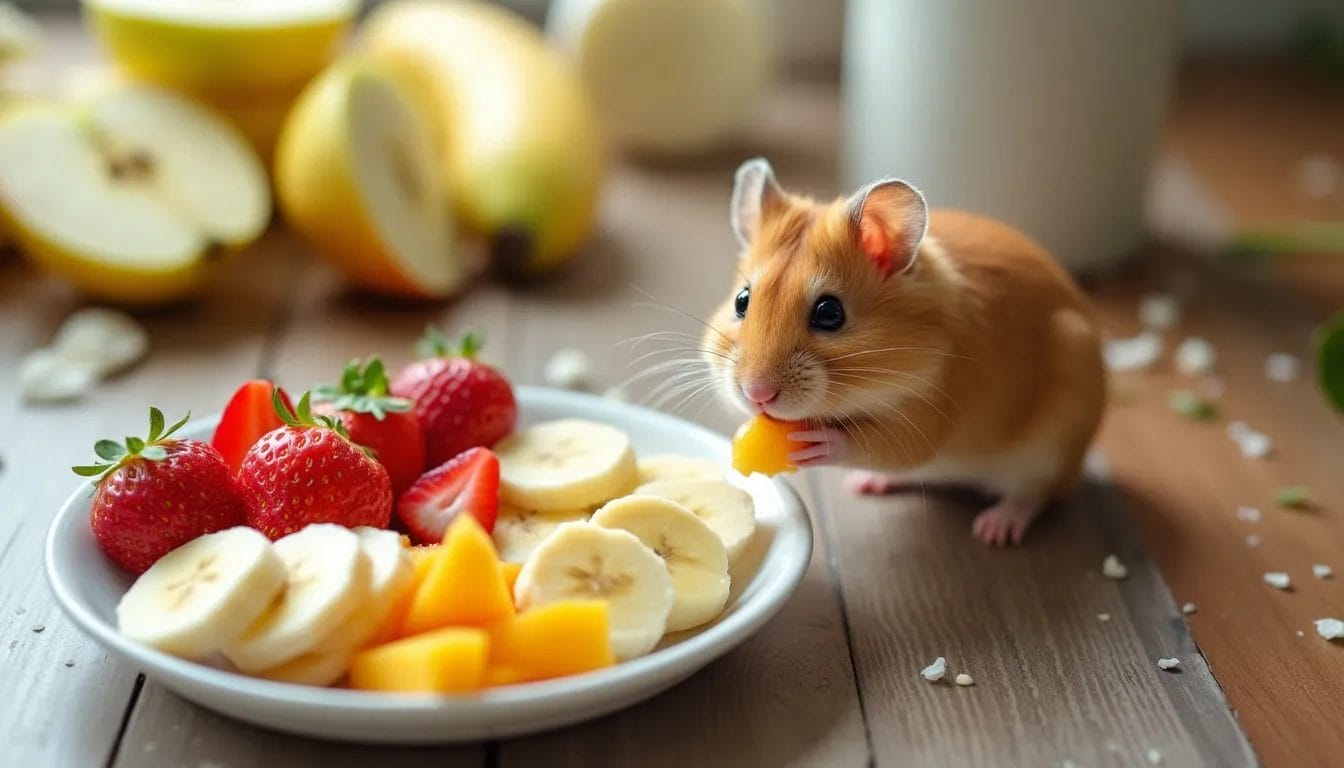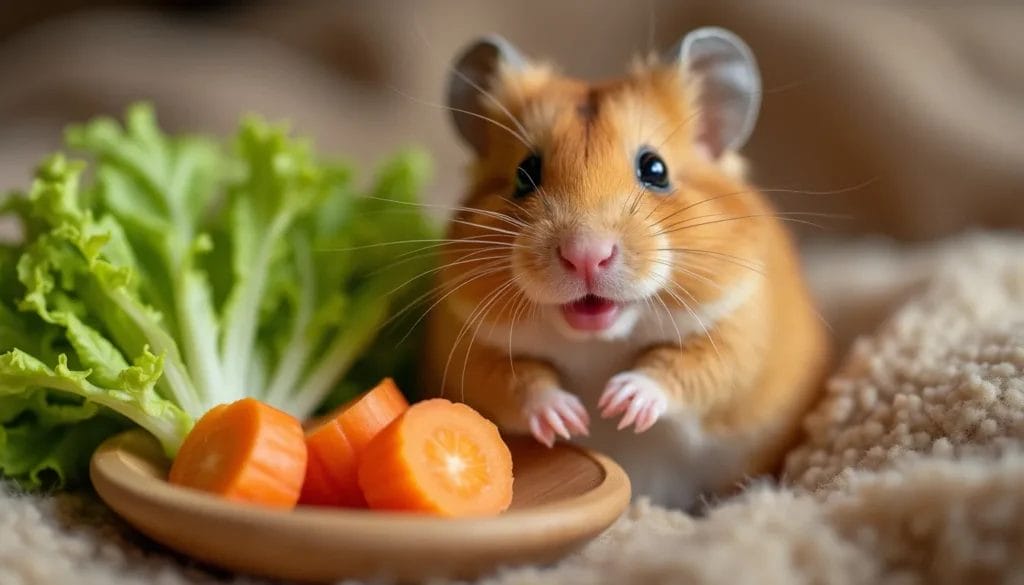
As a proud hamster parent, I always want the best for my furry friend. After countless hours spent researching and experimenting with various snacks, I’ve compiled a definitive list of fruits and vegetables that are not only safe but beneficial for hamsters. From juicy grapes to crunchy carrots, let’s dive into the delightful world of hamster nutrition!
Understanding Hamster Diet Basics
Why Balance Matters
It’s essential to understand that a balanced diet is crucial for hamsters. Just like us, they need a variety of nutrients to stay healthy. Think of it this way: What happens when we eat only one type of food? We can get sick or feel weak. The same goes for our furry little friends!
Hamsters require a mix of:
- Protein – for growth and repair.
- Carbohydrates – for energy.
- Fats – for healthy skin and a shiny coat.
Common Myths About Hamster Feeding
There are many misconceptions out there. One common myth is that hamsters can eat anything humans do. This is misleading! Not all human foods are safe for hamsters. For example, while treats like grapes and strawberries are great, foods like cheese can be harmful.
“A well-fed hamster is a happy hamster!” – Pet Nutrition Expert
The Role of Fruits and Vegetables
Fruits and vegetables play a vital role in a hamster’s diet. They provide essential vitamins and minerals. However, they should only be given in moderation. Too much sugar from fruits can lead to health issues.
Safe Options for Hamsters
Here’s a quick look at some fruits and vegetables that are safe for hamsters:
| Food | Can Eat? | Notes |
|---|---|---|
| Grapes | Yes | Rich in vitamins C and K |
| Strawberries | Yes | High in vitamin C |
| Banana | Yes | Limit due to sugar |
| Blueberries | Yes | High in antioxidants |
| Cucumber | Yes | Hydrating and low in calories |
Always remember: The right balance matters for a hamster’s longevity. They are omnivores, requiring fruits, vegetables, and protein to thrive. Offering the right diet keeps them happy and healthy.
Next time you consider what to feed your hamster, think about this: Are you giving them a varied diet? A little research can prevent many issues down the line!
Top Fruits and Vegetables Hamsters Can Enjoy

As devoted hamster owners, we always want to provide the best for our furry friends. One essential aspect of their diet is incorporating fruits and vegetables. Let’s dive into which fruits and veggies are not only safe but also delightful for your hamster!
Safe Fruits for Hamsters
- Apples: Yes, hamsters can eat apples! Just remember to remove the seeds as they contain cyanide. A small piece, about a teaspoon, is sufficient once or twice a week. They’re a great source of fiber and vitamin C.
- Strawberries: These tasty berries are a fantastic choice. A thin slice or one small strawberry can be given weekly. They are packed with vitamin C and antioxidants.
- Bananas: While bananas are high in potassium and dietary fiber, they should be offered sparingly. A small slice (about a quarter teaspoon) once a week prevents your little buddy from gaining unnecessary weight.
It’s important to note that fruits should be given in moderation. They contain natural sugars that could lead to obesity if overfed. So, how often should you offer fruits? Weekly is ideal.
Vegetables That Make a Great Snack
- Carrots: Rich in vitamin A, they support good eyesight. A small slice once or twice a week is enough.
- Cucumber: This hydrating veggie can be served a few times a week. Just a small slice will keep your hamster refreshed!
- Bell Peppers: A colorful treat, bell peppers are packed with vitamins C and E. Offer a small slice 1-2 times a week for a crunchy snack.
Don’t forget to introduce new foods gradually. Start with small amounts to see how your hamster reacts. Observing their response can help you avoid any tummy troubles.
Recommended Serving Sizes
| Fruit/Vegetable | Recommended Serving Size | Frequency |
|---|---|---|
| Apples | 1 teaspoon | 1-2 times a week |
| Strawberries | 1 small strawberry | Once a week |
| Bananas | 1/4 teaspoon | Once a week |
| Carrots | 1 small slice | 1-2 times a week |
| Cucumber | 1 small slice | Few times a week |
| Bell Peppers | 1 small slice | 1-2 times a week |
In summary, I find offering a mix of fresh vegetables and fruits keeps things exciting for our hamsters. Remember,
“Fruits and veggies make for a colorful and healthy hamster diet.” – Animal Nutritionist
. With proper portion control and a watchful eye on your pet’s reaction, we can help our little companions lead happy, healthy lives.
Foods to Avoid: What Hamsters Should Never Eat
When it comes to our furry friends, knowledge is power. As a proud hamster owner, I often wonder: what foods are downright dangerous for my pet? It’s crucial to understand that not all foods safe for us humans are safe for hamsters. Some seemingly harmless snacks can stir up serious health issues for them.
1. Overview of Toxic Foods
Let’s kick things off with a few major offenders. Hamsters should never munch on:
- Chocolate: This sweet treat contains theobromine, which can be lethal to hamsters.
- Onions: These can cause digestive problems and even lead to anemia.
- Cheese: Although it may seem like a fun snack, hamsters are lactose intolerant. Feeding them cheese can cause serious digestive upset.
2. Seemingly Healthy Foods to Avoid
Some foods may appear healthy on the surface. However, they can turn harmful. For example:
- Tomatoes: While ripe tomatoes are packed with vitamins, the green parts are toxic.
- Fruits high in sugar: Items like bananas and mangoes can lead to obesity if overfed.
So, what’s the takeaway? Always do your homework before introducing any new human food into your hamster’s diet. It’s a small step that can lead to a big difference in your pet’s health!
3. Signs of Food Intolerance or Allergies
Even with healthy fare, some hamsters might still experience intolerance or allergic reactions. Watch for these signs:
- Diarrhea: A sudden change may indicate a food issue.
- Scratching or skin irritations: This could suggest an allergy.
- Lethargy: If your hamster seems more tired than usual, it could be due to dietary issues.
Keeping an eye on your pet’s behavior after introducing new foods can prevent potential problems. Remember, “An informed pet owner is an empowered pet owner!” – Vet Tech.
4. The Importance of Awareness
Being aware of harmful foods not only keeps our little pals safe but also prevents health complications in the long run. It’s a small effort for a healthy, happy hamster! As a hamster owner, I take pride in ensuring my pet thrives, and that starts in the kitchen.
Creative Ways to Serve Fruits and Vegetables to Your Hamster

Hamsters are not just adorable little furballs; they are also picky eaters! Keeping their diet interesting is crucial for their health and happiness. Here are some creative ways to serve fruits and vegetables to your furry friend.
1. Fun Fruit Presentation
Why not get a bit artistic with your hamster’s meals? Here are some fun ideas:
- Slice & Dice: Cut fruits like apples and bananas into fun shapes using cookie cutters.
- Mix & Match: Create a colorful fruit salad with different safe fruits, like blueberries, strawberries, and grapes.
- Fruit Skewers: Pop small pieces of fruit on a safe wooden stick for a delightful treat!
2. Homemade Treats
Creating homemade treats can deepen your bond with your pet. Plus, you get to control the ingredients!
- Fruit Purée: Blend safe fruits into a puree. Spread it over whole-grain crackers for a tasty snack.
- Frozen Treats: Freeze small fruit cubes or vegetable pieces in water to offer a refreshing snack on hot days.
3. Engaging Feeding Time
Feeding time should be fun! It’s a chance to engage your hamster. Here are some ideas:
- Food Puzzle: Hide small chunks of fruits or veggies around their habitat to encourage exploration.
- Interactive Feeders: Use toys that dispense treats when manipulated, adding a playful element to dining.
“Healthy snacks can double as playtime!” – Pet Behavior Specialist
Why Rotate Food?
Rotating fruits and vegetables is not just safe; it provides various nutrients. Here’s a quick look at *some benefits*:
| Fruit/Vegetable | Nutritional Benefit |
|---|---|
| Apples | High in fiber and vitamin C |
| Blueberries | Rich in antioxidants |
| Carrots | Good for vision, high in beta-carotene |
| Strawberries | Boosts the immune system |
Incorporate fruits and vegetables in various shapes and sizes, which keeps feeding time exciting. Remember — safe homemade treats foster a deeper connection with your pet. By offering them a variety, you ensure they look forward to mealtime, and you also give their health a boost! Let’s not forget — serving food creatively can make a meal as much fun as it is nutritious!




